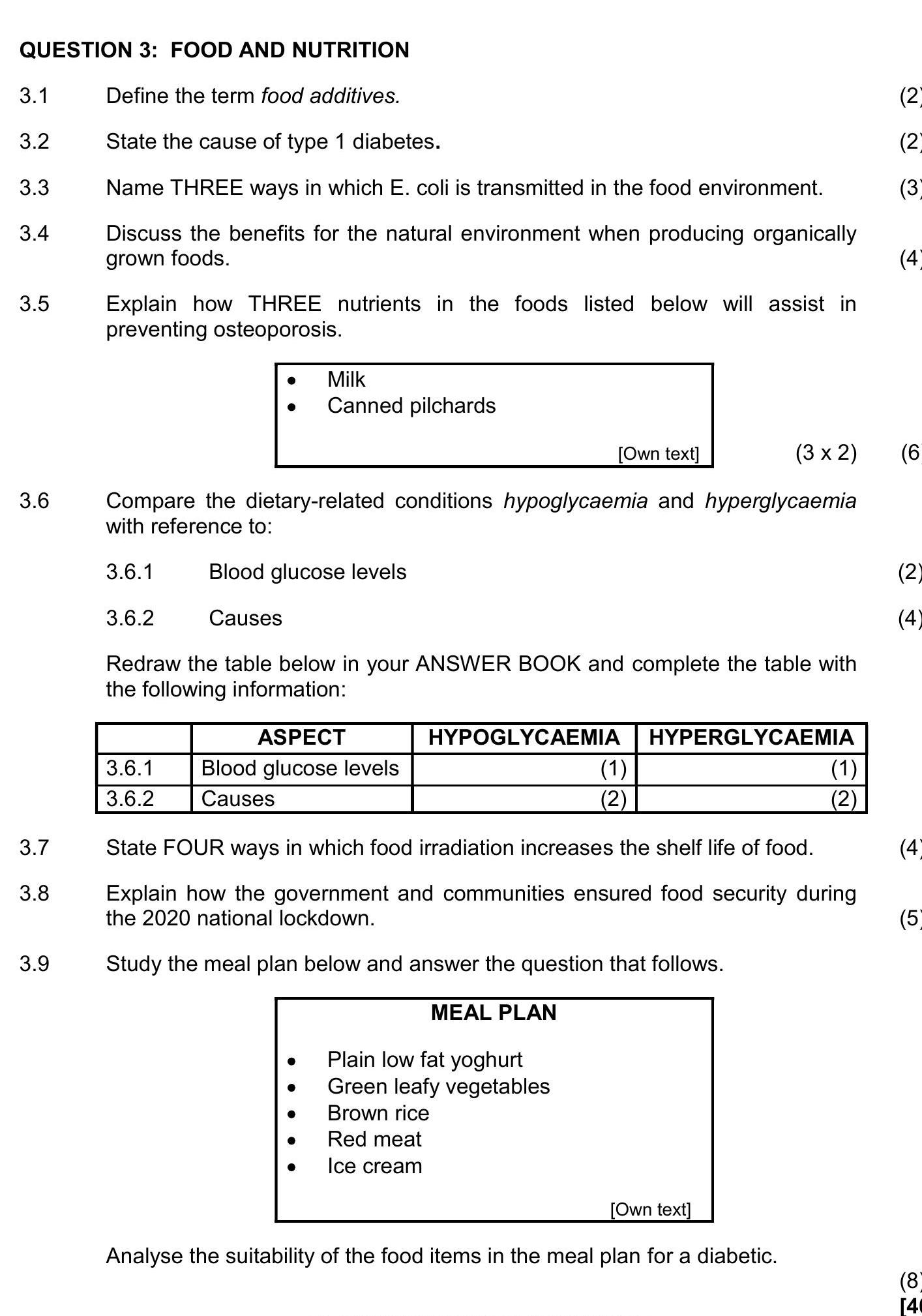Photo AI
3.1 Define the term food additives - NSC Consumer Studies - Question 3 - 2021 - Paper 1
Question 3

3.1 Define the term food additives. 3.2 State the cause of type 1 diabetes. 3.3 Name THREE ways in which E. coli is transmitted in the food environment. 3.4 Discu... show full transcript
Worked Solution & Example Answer:3.1 Define the term food additives - NSC Consumer Studies - Question 3 - 2021 - Paper 1
Step 1
Step 2
Step 3
Step 4
Discuss the benefits for the natural environment when producing organically grown foods.
Answer
Producing organically grown foods benefits the environment in several ways:
- Improved Soil Quality: Organic farming enhances soil health by avoiding synthetic chemicals and focusing on crop rotation and natural fertilizers.
- Water Conservation: It reduces pollution and prevents harmful chemicals from running off into water supplies, thus keeping water sources clean.
- Biodiversity: Organic practices support a variety of organisms and contribute to ecological balance, protecting wildlife habitats.
- Reduced Chemical Use: Farmers utilize fewer harmful chemicals, which can adversely impact local flora and fauna, maintaining a healthier ecosystem.
Step 5
Explain how THREE nutrients in the foods listed below will assist in preventing osteoporosis.
Answer
- Calcium in milk: Essential for strengthening bones and increasing bone density.
- Phosphorus in canned pilchards: Works alongside calcium for proper bone development and maintenance.
- Protein in fish: Contributes to connective tissue synthesis, which is important for overall bone health.
Step 6
Compare the dietary-related conditions hypoglycaemia and hyperglycaemia with reference to Blood glucose levels.
Answer
3.6.1 Blood glucose levels:
- Hypoglycaemia: Characterized by low blood glucose levels.
- Hyperglycaemia: Characterized by high blood glucose levels due to insulin resistance or inadequate insulin production.
Step 7
Compare the dietary-related conditions hypoglycaemia and hyperglycaemia with reference to Causes.
Answer
3.6.2 Causes:
- Hypoglycaemia: Can occur due to skipping meals, irregular eating, or consuming high glycemic index foods.
- Hyperglycaemia: Often results from diabetes, where excessive sugar builds up in the bloodstream due to insufficient insulin usage.
Step 8
State FOUR ways in which food irradiation increases the shelf life of food.
Answer
- It delays the ripening process of fruits and vegetables.
- It controls the sprouting of certain vegetables like potatoes.
- It destroys bacteria and pathogens that could spoil food.
- It reduces the need for chemical preservatives.
Step 9
Explain how the government and communities ensured food security during the 2020 national lockdown.
Answer
The government and communities worked together to maintain food security by keeping shops open for public access, providing financial assistance to the unemployed, and ensuring the supply of food parcels through various organizations. Communities also started initiatives to support local food production to meet basic needs.
Step 10
Analyse the suitability of the food items in the meal plan for a diabetic.
Answer
The meal plan contains:
- Plain low fat yoghurt: Suitable, as it is low in sugars and dost not significantly affect blood glucose levels.
- Green leafy vegetables: Beneficial as they are low in calories and high in fiber, assisting in glucose regulation.
- Brown rice: Preferable over white rice due to its lower glycemic index, allowing for slower digestion.
- Red meat: Should be consumed in moderation as it can increase cholesterol levels, posing cardiovascular risks.
- Ice cream: Generally unsuitable due to high sugar content, which can cause spikes in blood glucose levels.
